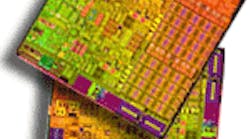On Semiconductor’s AMIS- 49587 powerline carrier (PLC) modem does more than remotely read smart electric automatic meters. It invites a closer look at street lighting control, smart power plugs, building automation, and other applications that are part of the Smart Grid, which is a potentially disruptive technology that may offer new opportunities for design engineers (see “Smart-Grid Report Maps Opportunities For U.S. Engineers”).
The AMIS-49587 integrates an analog modem front end and digital post-processing. It’s a halfduplex S-FSK modem for PLC data transmission on low-voltage or medium-voltage powerlines that completely handles the physical and media-access control (MAC) protocol layers. It operates from a single 3.3-V power supply and interfaces with the powerline via an external power driver and transformer (see the figure).
An internal phase-locked loop (PLL) locked to the mains frequency synchronizes the tones with the powerline’s zero-voltage crossings. Each zero crossing can convey 3, 6, 12, or 24 data bits, with decreased sensitivity to timing as the number of bits increases. On the chip, signal conditioning and conversion starts at the analog front end and continues in an ARM microprocessor core after the signal is converted to the digital domain.
That “S” (for “spread”) in the frequency-shift keying (FSK) designation is interesting. On’s datasheet says that S-FSK “combines some of the advantages of a classical spread-spectrum system” with classical FSK simplicity. As in any FSK scheme, mark and space frequencies (fM and fS) represent ones and zeros. In S-FSK, fS and fM are widely separated.
On the transmission medium, then, the strengths of the small interferences and the signal attenuation are independent at the two frequencies, providing a degree of immunity against narrow-band interferers. For the AMIS-49587, mark and space are in the range of 9 to 95 kHz with a typical 10-kHz separation.
S-FSK is defined by IEC 61334 (formerly IEC 1334), which is a series of standards designed explicitly for remote meter reading. The AMIS-49587 also complies with the EN 50065 specification for signaling on low-voltage electrical installations from 3 to 148.5 kHz.
The AMIS-49587 is currently available, and budgetary pricing is $11.00 for quantities of 1000 units and above. Additionally, evaluation kits are available. The datasheet can be accessed online at www.onsemi.com/pub_link/Collateral/AMIS-49587-D.PDF.
DON TUITE
ON SEMICONDUCTOR
www.onsemi.com
